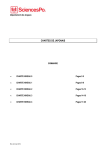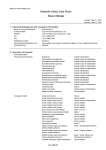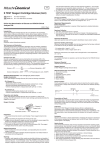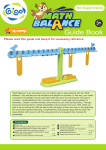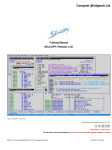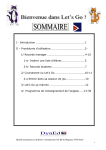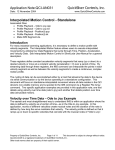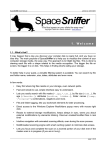Download Dynamic Japanese Study Guide
Transcript
Table of Contents Introduction _______________________________________________________________________________ 3 Course Structure & Sequencing ____________________________________________________________________ 3 Contents for Dynamic Japanese 1 _____________________________________________________________ 5 General Study Tips _________________________________________________________________________ 6 Getting Started _____________________________________________________________________________ 8 How to do the first lesson, Names and Places __________________________________________________________ 8 How to do the second lesson, Numbers and Times: ____________________________________________________ 10 How to do Kana Practice _________________________________________________________________________ 11 How to do the Dictations and Fill-Ins _______________________________________________________________ 12 Dictations _____________________________________________________________________________________ 12 Fill-Ins ________________________________________________________________________________________ 14 Appendices _______________________________________________________________________________ 15 Introduction Welcome to Dynamic Japanese! This introductory course in spoken Japanese is based on classroom proven instructional strategies and techniques. Dynamic Japanese maximizes the effectiveness of multimedia by focusing on the key skill necessary to acquire any language: listening. Each disc contains many hours of listening practice with native speaker models, plus a variety of listening tasks and follow-up exercises. The language is carefully chosen and sequenced to ensure comprehension at each level while at the same time remaining natural. With DynEd's unique interactive design, students can study at their own pace. At any point in the program students have instant access to repetition, an English translation, Japanese text display, and glossary screens that provide additional information about vocabulary and language points of particular importance. Students may also record their own voice as many times as they like and compare it with the native speaker models. Course Structure & Sequencing Dynamic Japanese I is the first of three levels. Each level is divided into two parts, Discs 1 and 2. Normally, each Disc requires a minimum of 40 hours of study and practice. Completion of all six discs will take the learner from beginner to intermediate proficiency in spoken Japanese. The course builds in a spiral from the most basic personal information of name and nationality, to family and living situations, to daily schedule and routines, and continues on so that students can communicate in ever increasing detail about themselves and the world around them. The language sequencing is based on the following: Short term memory: For students to process and repeat a phrase, they must first be able to hold it in short term memory. Intensive listening practice and repetition of short phrases is necessary to build the ability to hold longer phrases in memory. Language concepts: The grammar and vocabulary items chosen must aid students in communicating the basic concepts necessary to talk about themselves and the world around them. These concepts include number, time, frequency, duration, manner, means, object, beneficiary, etc.... The sequencing of these language concepts should lead to an ability to go from general information to more detailed information. Spiral sequencing: To aid the student in language acquisition, key vocabulary and grammar should be constantly reviewed and practiced, even as new material is introduced. Comprehensible input: For language acquisition to occur, the input language must be understood. For this reason, in addition to the visual support provided by the graphics in each lesson, an oral translation is provided for each sentence, along with glossary support. Context: All language must be presented in context. Each context should support the language, and should be adaptable to the student's own life and situation. Dynamic Japanese has been designed to work well with other more traditional courses. Unlike text based courses, the main focus of Dynamic Japanese is on listening and speaking. Though the Japanese writing system is introduced and used throughout, students may need to use an additional text as a supplement. For more in-depth information on Japanese grammar and situations, several excellent textbooks can also be recommended. (See General Study Tips, below) Contents for Dynamic Japanese 1 Disc 1 Names & Places: This first lesson begins with very short phrases that are useful for expressing basic personal information: name, nationality, gender, country, place of origin and spatial location. Also included are useful phrases for introductions. Basic grammatical patterns are used throughout, supplemented by glossary notes. Numbers & Times: Intensive listening practice with numbers and times help tune the ear to the Japanese sound system. Jobs & Family: The jobs, families, and living situations of three characters are presented and contrasted. New grammatical patterns and useful vocabulary are introduced. Kana Practice: This lesson gives practice with the Japanese hiragana writing system. Dictations: Reviews previous material while focusing on important vocabulary, grammar, and kana recognition. Fill-Ins: Gap-filling exercises provide intensive reading, grammar, and vocabulary practice. Disc 2 Family Schedule: Family relationships are extended as we focus on a Japanese family of four. The daily schedule of each character is presented, including times, daily activities, and days of the week. Matrix Vocabulary: This highly interactive lesson introduces a wide variety of useful vocabulary relating to: seasons, times of day, weather, times of life, and types of people. Matrix Game: An interactive game format based on the Matrix Vocabulary. Try to improve your score until you have learned every word! Likes & Dislikes: A character talks about what foods he likes. He then talks about his other interests, what he can and can't do, including sports, and how well he does them. Dictations: Reviews previous material while focusing on important vocabulary, grammar, and kana recognition. Fill-Ins: Gap filling exercises for intensive reading practice and review . General Study Tips 1.First, learn how to use the program. Familiarize yourself with the Control Bar. This information is in the DynEd User's Guide. Use each button, and get familiar with the mouse. If you hear an instruction in Japanese, use the translation button to hear it in English. Go slowly. Use the pause button, the repeat button, and the translation button untilyou are confident. It generally takes time to familiarize your ear to the sounds and rhythms of Japanese. 2.Use the pause button whenever you need time to answer a question or to stop and think. If you don't do this, the program may time out and exit you from the lesson. You are in control, but only if you use the mouse to click on the control buttons. You will always have plenty of time if you get into the habit of using the pause button. Once you do this, the learning experience will be enjoyable. 3.Study for 20-30 minutes at a time. If you are a beginner, concentrate on the first 15-20 sentences only. Don't try to go through an entire lesson. Each lesson will require several hours of intensive study, practice, and review. If you go too fast, you will become frustrated and overwhelmed by the language. Please pace yourself. For most students the first CD of Dynamic Japanese will require a minimum of 40 hours of study and intensive practice. 4.If you don't understand something, use the translation button. Most instructions are given in Japanese. Please use the translation for these instructions until you begin to understand the Japanese. 5.If you cannot read hiragana and katakana, don't attempt the Dictation and Fill-in units until you have mastered all the other lessons, including the Kana practice lesson. The dictations and fill-ins will require effort, but will be worth it once you can do them. They should be reviewed periodically. 6.Find a good textbook to use as a reference and to help you learn the grammar and writing system. The main focus of Dynamic Japanese is listening. Though the Glossary provides some help with the grammar, the more difficult points will require a good textbook or a teacher. Some excellent textbooks are: Japanese for Busy People (Kodansha International), Japanese For Everyone (Gakken), Business Japanese (Nissan Motor Co., Ltd.), and Situational Functional Japanese (Bonjinsha) General Comments Learning a language is like learning how to play a musical instrument. It is a skill that must be acquired over time, through constant practice and repetition. The more time you spend in each lesson, the more you will learn. As with learning to play an instrument, practice time must be focused to be effective. Each time you study you should have a purpose or goal for that practice session. This helps you to concentrate and facilitates long-term acquisition of the language. Each lesson will normally require several hours of study, practice, and review. It is important to study each of part of a lesson several times, before going on to the next part or section. Getting Started How to do the first lesson, Names and Places If you don't know how to get into the lesson, please look at the DynEd User Manual. When you start the first lesson, follow this procedure to familiarize yourself with the program. 1. For each sentence, click on the pause button so that it is flashing red. 2. With the pause button flashing, click on the repeat button. pause button will continue to flash. This will repeat the sentence. The 3. Click on the American flag. continue to flash. This will give you an English translation. The pause button will 4. Click on the ABC button. lighted words to see the Glossary. This will give you the text of the sentence. Click on one of the hi- 5. Next, click on the flashing pause button so that it stops flashing. This will take you to the next sentence. Please remember that when the pause button is flashing red, the program is paused. To continue, you must click on the flashing red button, or, if a question is being asked, you may click on an answer. 6. Repeat the above series of steps for each new sentence. To go back, click on the rewind button, or exit the lesson. (See DynEd Controls in the User's Guide) 7. When you come to a comprehension question, the program will time down and wait for you to click on an answer. If you don't know what to do, click on the <?> button on the control bar, next to the pause button. If you want to hear the question repeated, click on the repeat button. 8. After you have listened to the first few sentences a few times, go back and repeat each sentence. To go back, keep clicking on the rewind button until you are at the first sentence. 9. To record your voice, click on the record button button to hear your recording. which will turn red. Then click on the monitor To compare your recording with the Japanese native speaker, click on the repeat button, and then the monitor button. Repeating each sentence is an excellent way to improve both your listening and your speaking. If a sentence is too long, try repeating just the first or last part of it. If this is still too difficult, go through the sentences again without repeating them until you feel more confident. Don't try to practice speaking until you are comfortable with the sounds and can hold them in your memory. 10. After about 20-30 minutes, stop. Don't try to do too much the first time. This first unit, Names and Places, will require several hours of practice before you will be ready to go on to the second unit, Numbers and Times. How to do the second lesson, Numbers and Times: 1. Begin with the numbers. Click on each number and listen. Do this several times, for each number. 2. When you think you know the numbers, click on the Question Box button: This will allow you to test yourself. In this mode you will hear a number, and you will see several choices displayed on the screen. To hear a repetition of the number, click on the repeat button. Then, click on the correct choice. If you wish to see the text, please click on the ABC button, which will display the text. If you click on a hi-lighted word, you will see a Glossary screen that will give you additional information. 3. If you time out, the program will automatically repeat the number. If you time out twice, the program may think you are not there and will exit the lesson. To avoid timing out, use the pause button or the repeat button. This will stop the program from timing out. 4. After you have mastered the numbers, enter the lesson again and study how to tell time. Since telling time requires a knowledge of numbers, this lesson reviews your knowledge of the numbers while you study how to tell time. 5. This lesson is excellent listening practice and should be repeated often. How to do Kana Practice 1.Click on each word and listen. Do this several times, for each word. You may wish to use the ABC button for text support. 2.Listen to each word, then say it. Practice reading each word. 3.When you think you are ready, click on the Question Box button: This will allow you to test yourself. In this mode you will hear a word, and the program will time down as it waits for you to indicate the correct answer. For more time, click on the pause button or use the repeat button to hear the word again. You may hear the word as many times as you wish before you make a choice. If you wish to see the text, please click on the ABC button, which will display the text. If you click on a hilighted word, you will see a Glossary screen that will give you additional information. 4. When you have mastered one set of words, click the <+> button on the Control Bar to go to another set of words. Altogether, there are six sets of 14 words, or 84 words in total. How to do the Dictations and Fill-Ins These lessons review the language from the previous lessons. They also require a reading knowledge of hiragana. To prepare for these lessons, please do the Kana practice lesson first until you are able to recognize the words written in hiragana. You may also wish to review all the previous lessons with the text support turned on. To do this, go to the Control Panel menu and turn on the text support. This will allow you to see the text display as you review the lessons. Dictations In the Dictation lesson you will first hear the sentences presented in order. Then the screen will change and you will see a group of 15 words displayed at the top of the screen. In the Control Bar, you will see the numbers 1-4 displayed. To do the dictation, follow these steps: 1. Click on the number 1 in the control bar. You will then hear the first sentence, and it will be displayed on the screen with a number of blanks spaces where words are missing. 2. Click on the repeat button to hear the sentence again. This will also pause the program so that you have plenty of time. 3. Look at the words at the top of the screen. Your task is to find which word goes in each blank. Then click on your choice on it until it turns red. Next, click on the space in the sentence where you want the word to go. When you do this, the word will appear in the blank space. If you have made a mistake you may change your choice by putting another word in the same place. 4. Continue this process until you have finished the first sentence. 5. Click on the number 2 in the control bar, and follow the same procedure. 6. When you have completed all four sentences, click on SCORE in the Control Bar. This will check your answers and give you a score. 7. If your score is less than 65%, you will have a chance to do the dictation again. 8. If you score is more than 65%, you will hear each sentence again, and the sentences will be reentered on the screen. Your errors will be indicated by colored text, and you will have the chance to correct them. 9. For example, to correct an error in sentence 1, click on the number 1 in the control bar and listen to the sentence. Then find the correct answer, click on it, and use it to replace the incorrect word. If your choice is correct, the color of the word will turn white. 10. When you have finished correcting your errors in the dictation, click on END in the Control Bar. You will then have a chance to repeat the same dictation or move on to a different dictation. You may also decide to exit the 11. lesson and return to the main menu. Remember to use the translation button if you do not understand the instructions. Fill-Ins This lesson will help you focus on important grammar and vocabulary items from the previous lessons. 1. Read each sentence and note the blank space. Try to decide what word should go in the blank. 2. Look at the group of 5 words displayed on the screen. Decide which of these words can go in the blank. 3. Click on your choice. 4. You will generally have two chances to get the correct answer. Then the program will show you the correct answer. 5. To find out more about the answer, click on the hi-lighted word in the answer, and a Glossary screen will appear which may help you better understand the answer. 6. Try doing all the fill-ins in sequence by clicking on the numbers in the choice menu. Then, click on the Question Box button, and you will have a chance to test yourself by doing the same problems in a random order. Good luck. 7. These problems will need to be reviewed often, as they are important. Appendices


















